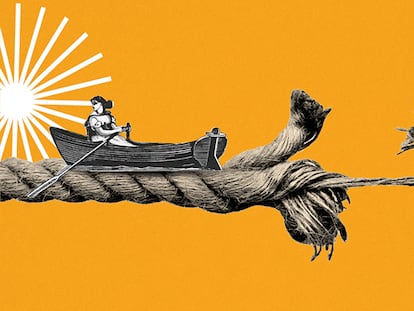Science analyzes 150 years of literature: How fiction has reinforced the stereotype of the passive woman
A large-scale study reveals persistent patterns of gender inequality and female underrepresentation in the narrative of more than 87,000 novels and short stories published in the US

Passive, dependent and submissive women do exist. In fiction, at least. The belief that many of the stereotypes associated with femininity come from artistic and cultural manifestations has always existed, but now science corroborates it. The researcher Oscar Stuhler has used computer programs to examine more than 87,000 short stories and fiction novels published in the last century and a half, analyzing the interactions between the characters. The result, published in the journal PNAS, draws an incontestable pattern: women have been repeatedly portrayed as more passive, especially when written about by male authors.
How do you calculate something as seemingly subjective as passivity in such a vast database? Stuhler, a sociologist at Northwestern University in Illinois, mined and examined networks of interactions between characters to measure so-called gender agency. A character’s degree of agency is determined by whether he or she “primarily serves as an agent acting upon the other character or as recipient acted upon by the other character.” By this criterion, women in works of fiction are not only more passive in general, but are also more passive when interacting with men, according to the author’s results. It’s called the “gender agency gap.”
The same thing happens in cinema, the author explains, where many of the stories in films are told through a male gaze and it is usually men whose actions have an impact on women. In fiction, men are everything: heroes, villains and helpers. “It is interesting, but not entirely surprising, especially if we take the notion that gender is a social construct that must be represented and acted out,” he notes. In other words, the sociologist explains, gender itself is based on certain practices that are culturally codified as masculine or feminine.
Literature reflects what happens in a world that is constantly changing. This is demonstrated by the study, which also observed the female protagonism in works over time, comparing it with the historical moment in which they were described. For much of the 20th century, women portrayed in fiction did not have much capacity for action or control over their lives, coinciding with a time when roles in work and society were very clearly defined and inclined towards men, especially in the 1950s and 1960s in the United States. But the trend changed in the following two decades, when feminism exploded and women began to have more power. In part, the author of the research considers that this is due to the fact that more female authors began to emerge who wrote stronger female characters into their pages. Thus, agency evolves along with gender norms, which have become less strict over time, while stereotypes have been reduced.
Man kisses woman
The programs have measured agency based on cross-character interactions, classifying them by the gender of the person performing the action and using the formula man → woman, and vice versa. Here are some results:
- Who has more agency? Male → female actions made up 26.6%, compared to 23.1% for female → male actions.
- Man kisses woman. 65% of kisses between male and female characters were initiated by men, while only 35% came from women.
- Women do not interact with each other. Actions between men represent 38.9% of the total in a work, while actions between women only 11.4%.
- Mansplaining. A curious trend that has come to light during the research is one that is now known as mansplaining, a concept that refers to the stereotypically masculine behavior of explaining things to women assuming that they know more than them about any given subject. It turned out that 61% of the explanations in the literature analyzed were made by a male character to a female character.
For the study, he used the NoverTM database, a compilation of 87,531 works of fiction written by 40,000 authors between 1850 and 2010 in university libraries across the United States. This is the largest and most comprehensive collection of English-language fiction in existence, reflecting the book-consuming preference of a “well-educated and literate” public, the author explains.
Challenges of a large-scale literary analysis
Stuhler places his work at the intersection of humanities and data science, and acknowledges that it can be difficult to communicate his results in a way that satisfies both communities. Those who conduct classical literary analysis typically look very closely at individual works or authors and “can view the study as reductionist,” the sociologist surmises. Large-scale analyses strip out details, so they may not do justice to each individual work. But he is comfortable with these barriers: “In exchange, we gain the ability to uncover broad cultural patterns and trends,” he says.
Another consideration that the author highlights is that the works studied are in English, but Stuhler believes that it would be very interesting to do a comparative analysis. “How do gender and agency relate in, say, Spanish literature, and how does this differ from American or German literature?” he asks. Teresa Iribarren, a professor of arts and humanities at the Universitat Oberta de Catalunya, agrees that it would be worthwhile to do an analysis in other languages, but anticipates that applying it, for example, in Spanish or Catalan, similar results can be expected, since the trends of underrepresentation have spread worldwide throughout history and persist today.
The author reflects that his study not only opens the door to future research, but also invites reflection on how to adapt methodologies to explore gender representation in diverse literary languages and cultures. Although notable progress has been made in reducing the gender gap, major challenges remain in equitable representation and the search for equality in fiction literature remains an evolving task that requires both continued analysis and renewed commitment.
Sign up for our weekly newsletter to get more English-language news coverage from EL PAÍS USA Edition
Tu suscripción se está usando en otro dispositivo
¿Quieres añadir otro usuario a tu suscripción?
Si continúas leyendo en este dispositivo, no se podrá leer en el otro.
FlechaTu suscripción se está usando en otro dispositivo y solo puedes acceder a EL PAÍS desde un dispositivo a la vez.
Si quieres compartir tu cuenta, cambia tu suscripción a la modalidad Premium, así podrás añadir otro usuario. Cada uno accederá con su propia cuenta de email, lo que os permitirá personalizar vuestra experiencia en EL PAÍS.
¿Tienes una suscripción de empresa? Accede aquí para contratar más cuentas.
En el caso de no saber quién está usando tu cuenta, te recomendamos cambiar tu contraseña aquí.
Si decides continuar compartiendo tu cuenta, este mensaje se mostrará en tu dispositivo y en el de la otra persona que está usando tu cuenta de forma indefinida, afectando a tu experiencia de lectura. Puedes consultar aquí los términos y condiciones de la suscripción digital.
More information
Últimas noticias
Maduro pleads not guilty before the federal court in New York: ‘I am still the president of Venezuela’
A new test can detect Alzheimer’s from a finger prick
UN team enters Sudanese city of El Fasher after paramilitary massacre: ‘It’s like a ghost town’
A recipe for resistance: Indigenous peoples politicize their struggles from the kitchen
Most viewed
- Gilles Lipovetsky: ‘If you want to live better and fall in love, take Prozac, don’t look to philosophy’
- Alain Aspect, Nobel laureate in physics: ‘Einstein was so smart that he would have had to recognize quantum entanglement’
- Alvin Hellerstein, a 92-year-old judge appointed by Bill Clinton, to preside over Maduro’s trial in New York
- Why oil has been at the center of Venezuela-US conflicts for decades
- Cuba confirms death of 32 of its citizens in the US attack against Venezuela











































